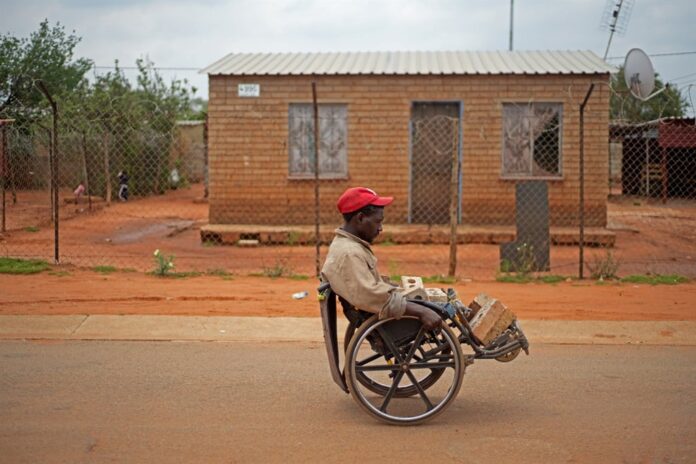Stilfontein – For over a decade, Qenelo Langa lived a life filled with the dangers and rewards of illegal mining, earning up to R22,000 a month. However, his world turned upside down after a tragic accident left him without both legs. Now, he faces a new reality of extreme poverty and uncertainty, a stark contrast to his once-thriving existence as a zama zama.
Langa, now 35, recalls the fateful day on 3 September 2020, when his life changed forever. While drilling for gold in the labyrinthine shafts of Stilfontein, a massive rock fell on his legs. “It was just like any other day underground. I was chipping at a rock with a crowbar in a tight space, sitting flat on the ground with my legs stretched out. Suddenly an enormous rock fell on my legs,” he said, his voice heavy with pain. The accident led to a harrowing journey to the local clinic and then to a hospital, but it ultimately resulted in the loss of his legs.
Now confined to a wheelchair held together with wire and cloth, Langa’s daily struggle is marked by uncertainty. “Each day, I have no idea where my next meal will come from and sometimes I go for days without food,” he lamented. His lack of an ID document has barred him from accessing a disability grant, leaving him in a dire situation. “My life’s such a struggle that sometimes I wish I’d died in that accident,” he confessed.
City Press encountered Langa on the streets of Khuma township, where he was attempting to collect bricks to build a room in the backyard of his aunt’s state-subsidised house. Currently, he sleeps in a car that no longer runs, a vehicle that cost the family R130,000, of which he contributed R75,000. So far, he has collected around 400 bricks in 14 days, carrying up to 20 at a time in his rickety wheelchair.
Langa’s journey into illegal mining began in 2010 when, as an orphan with no formal education or job prospects, he moved to Bekkersdal. Working as a zama zama, he eked out a living until around 2017 when he attempted to enrol in a trade school to train as a welder. Unfortunately, financial constraints forced him back into illegal mining.
Explaining the harsh realities of the underground world, Langa noted that permission to enter a mining shaft came at a price. A once-off fee of R15,000 was required to pay the syndicate operating the mine, a cost that could be deferred until gold was found. “They have spies underground there, making sure that you pay what’s due. Some people take chances and disappear into the maze of tunnels, but the consequences are dire if they’re caught,” he warned.
Life underground was fraught with danger but also opportunities. Langa explained that the longest he had ever stayed underground was six months, while others could remain for up to a year, surfacing only to extract their yield. He described a complex network where some zama zamas collaborated with legal mine workers, sharing tools and labour in exchange for a portion of the gold. “In the morning, they’d just load whatever we’d left for them,” he said.
However, the underground environment was not without its vices. Langa recounted how everything was available at a steep price, with basic goods like a two-litre bottle of cool drink costing R100 and a loaf of bread R200. He highlighted that strict rules governed life underground, with fines reaching R40,000 for violations. Miners had designated areas for smoking and were required to use containers for sanitation.
Today, Langa finds himself caught in the ongoing conflict between illegal miners and the police. The situation has worsened, with law enforcement employing increasingly harsh measures to force zama zamas out of the shafts. Minister in the Presidency Khumbudzo Ntshavheni’s statement that the government would rather “smoke out” the illegal miners than assist them has sparked outrage in the community.
Police Minister Senzo Mchunu visited the area recently and urged the community to present alternatives to the government’s approach. He warned against supplying the miners with food and water, claiming the police strategy was effective, as over 1,187 zama zamas had resurfaced and been arrested.
In a chilling incident, volunteers and community members attempted to rescue a weak, parched illegal miner using a pulley system, only to discover the decomposing body of another miner. This highlights the perilous conditions miners face and the desperation that drives them underground.
As Langa reflects on his past, he wonders what his life would be like if he still had his legs. “If I still had my legs, I would probably be among the zama zamas trapped underground right now,” he said, alluding to the miners stranded by police actions. The stark reality of illegal mining in South Africa reveals not only the dangers faced by those who participate in it but also the broader social issues that compel individuals like Langa to take such risks.
With no end in sight to the standoff between illegal miners and law enforcement, the future remains bleak for Langa and many others in similar situations. His story serves as a powerful reminder of the human cost of illegal mining and the urgent need for solutions that address the root causes driving individuals to seek their fortunes in the shadows.











